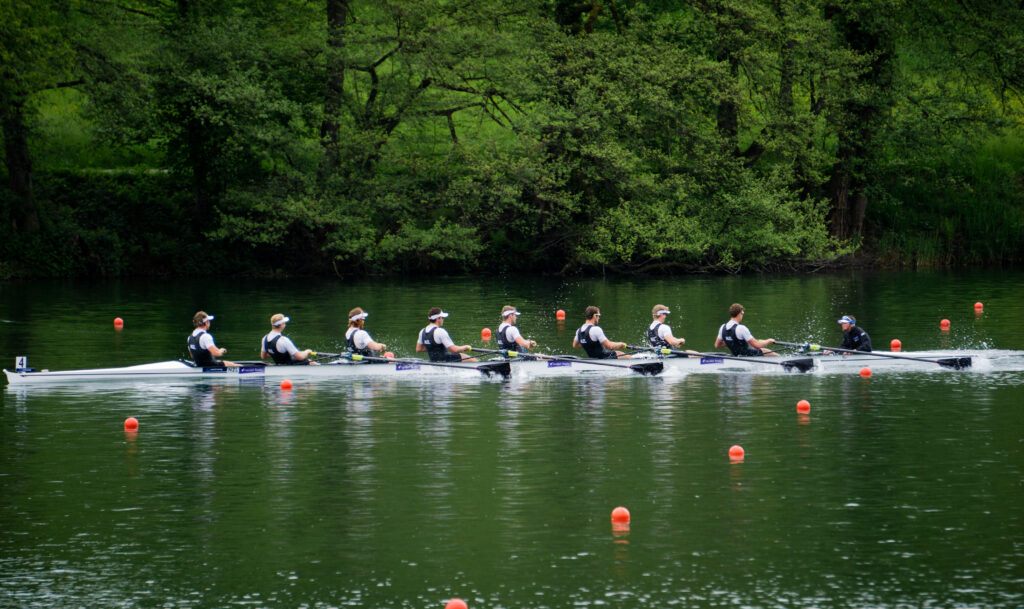
15 May 2021
Rowers descend on Lucerne for last Olympic qualification spots
The ‘Lake of the Gods’ in Lucerne, Switzerland fulfilled its promises as racing began Saturday, 15 May for the Final Olympic Qualification Regatta. The 2000m course was completely flat, with cool temperatures and a light decking of clouds overhead.
Women’s pair (W2-) – Heats
The first race of the day was the women’s pair and with just eight boats contesting, it meant two heats of four boats, with the top finisher qualifying directly to the Final. Russia shot off the start in Heat 1. Behind them were two sets of siblings, the Croatian Jurkovic twins and the Chilean Abraham sisters, who are two from a set of quadruplets. They were challenging hard going through the middle of the race. The Russians made a big move through the third 500m to secure their open water lead ahead of the field, Chile tried to move with them, but it was too little too late. Croatia, Chile and Germany will have to contend the repechage race.
The Danish put together a new lineup of Olympic silver medallist Fie Udby Erichsen and Olympic bronze medallist Hedvig Rasmussen. They were able to get out of the blocks the quickest in Heat 2, but the field was close behind them. Making the best of it was the young combination from the Czech Republic, with the Netherlands and Norway dropping slightly back. At 1000m Denmark found their rhythm and opened up clear water back to the rest of the field. Into the final sprint they looked smooth and controlled to claim the one spot into the Final.
Final qualifiers: Russia, Denmark
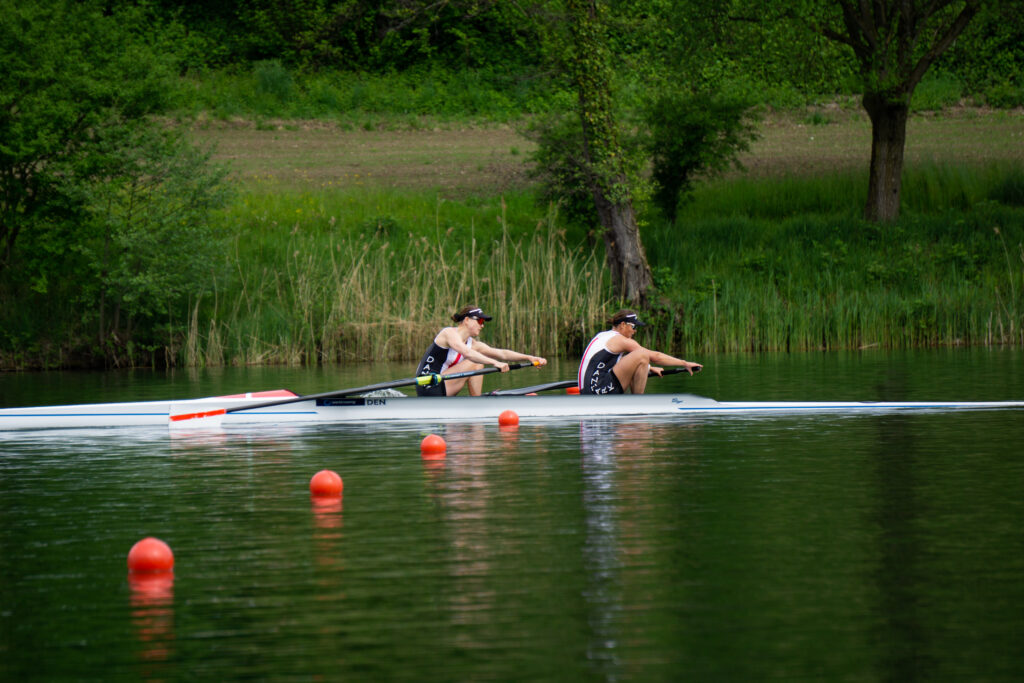
Men’s pair (M2-) – Heats
There were three spots available for the Semifinal in each heat of the men’s pair and in Heat 1 the third spot was hotly contested. The Danish got out to the early lead, with the crew from the United States staying right on their tails. But then the question was whether Chile or Russia would manage to take that third spot. As they came through the third quarter of the race, Chile upped their rate and pushed past Russia. The Russians looked willing to accept their fate in the repechage and powered down.
Heat 2 brought another closely contested race. Great Britain looked like the crew to beat coming into this race and they did take an early lead. Behind them it was Brazil, Poland and China. In the first half of the race, Brazil took that second spot and looked comfortable. In the third quarter of the race Brazil started to push up on the British, but the race was not over yet. In the last 500m sprint, Poland raised their rate and China decided to go with them. They inched closer to the Brazilians on the far side of the course. The finish line was drawing closer and the Brazilians faded. Poland managed to claim the second spot and China just pushed Brazil out of the direct qualification spot to the Semifinal.
Nicolas van Sprang and Guillaume Krommenhoek from the Netherlands were on fire as they went off the start in Heat 3 of the men’s pair. With four boats contesting for three spots it was again a race not be last. Germany, Slovenia and Hungary were desperately trying to stay out of that position. As the Dutch opened up their lead, Germany went with them. The final sprint saw Slovenia make a big push to shake the Hungarians. Hungary, resigned to their repechage race, took down their rate and tapped the boat across the line.
Semifinal qualifiers: Denmark, United States, Chile, Great Britain, Poland, China, Netherlands, Germany, Slovenia
Men’s double sculls (M2x) – Heats
The Czech Republic has been experimenting with new line-ups in the men’s double sculls. At the European Rowing Championships they tried a combination of Jakob Podrazil and Ondrej Synek, but then switched it up again for the first World Cup, bringing in the former lightweight rower Jan Cincibuch to replace Synek. Cincibuch and Podrazil are back together here in Lucerne and they had a fiery start in Heat 1. Italy boated a new combination of Luca Chiumento and Nicolo Carucci and they were looking smooth through the middle stages of the race, pacing themselves just behind the Czech Republic. These two crews opened up clear water back to the rest of the field to secure their spots in the Semifinal.
In Heat 2, it was Belgium and Russia who went out fastest at the start. The Belgians have been racing together since their under-23 years and their experience was helping them here in Lucerne. But it was the crew from Russia who found the best boat speed through 1000m and pushed past the Belgians. Into the final strokes, Ukraine made a move to push up on Belgium on the opposite side of the course, but it wasn’t enough. Russia and Belgium took the two spots directly to the Semifinal.
It was the first race of the day for Australia, who haven’t competed internationally since 2019. Campbell and David Watts were itching to race as they went off the start in Heat 3. But it wouldn’t be so easy because the Spanish had something to prove. They absolutely shot off the blocks, with the Australians desperately chasing. The Spanish rated an impressive 38 strokes per minute down the course, bumping it up to 40 as they came into the final 500m. In the final sprint, a glance across from the Australians to see where the Spanish were, they took up their rate. Both crews tested out their sprint as they powered to the line. Spain finished just a bowball ahead of Australia.
Semifinal qualifiers: Czech Republic, Italy, Russia, Belgium, Spain, Australia
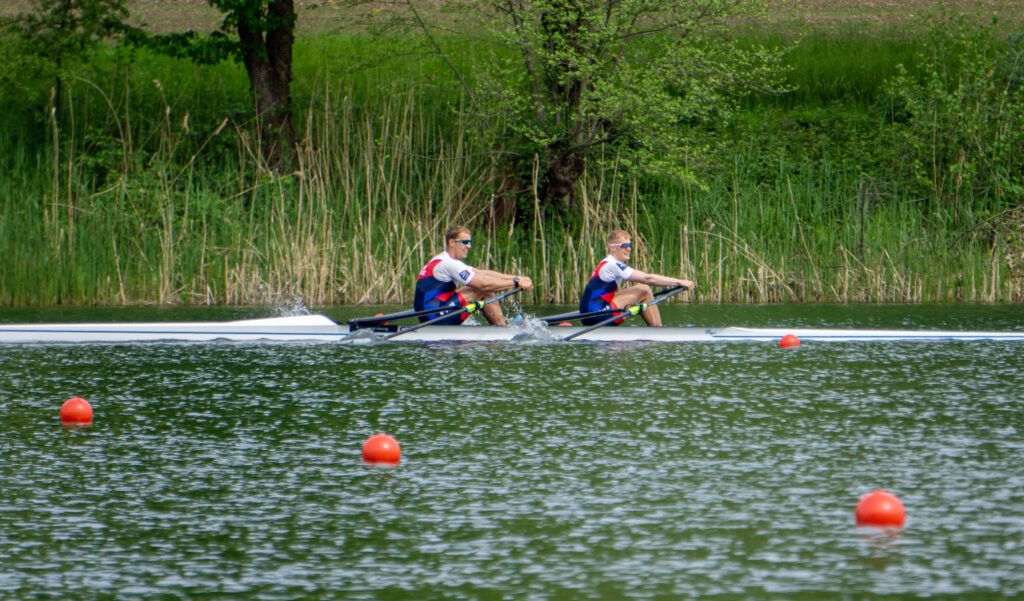
Women’s four (W4-) – Heats
The women’s four had seven entries, which meant the first crew from each heat would get a qualification spot directly into the Final. In Heat 1, there was just no doubt about the leader. Ireland led from start to finish with their Shamrock green blades splashing synchronously into the water. Despite having open water back to Russia, the Irish took up their rate in the sprint, just to practice their speed before the finals. Russia, Ukraine and Germany will have to contest the repechage.
Heat 2 of the women’s four brought a much closer race. The new crew from China got off to a fantastic start, rating over 40 strokes a minute. They were in the lead for the first 1500m of the race, but Italy did not give up. As they came toward just 500m to go, Italy lifted their rate. Alessandra Patelli glanced across from bow seat of the Italian crew and called for more power. In a desperate effort, the Italians pushed past China and claimed the one spot directly into the final.
Final qualifiers: Ireland, Italy
Men’s four (M4-) – Heats
The closest race of this morning hit the water in Heat 1 of the men’s four. It was five boats across as they went through 500m, with Belarus just poking their bow out in front. Through the middle of the race, it was only the Chinese who dropped slightly back off the pack. But with more than half to go, the race was far from over. Lithuania took up their rate, Ukraine went with them, while Belarus maintained their slight lead. Russia couldn’t keep up with the blistering sprint from the Lithuanians and the Ukrainians. Belarus, Lithuania and Ukraine managed to claim the three spots directly to the Semifinals, with Russia and China missing out.
There were just four boats in Heat 2, so it became a race not to be last. Canada made the best first half of the race, rating 40 strokes per minute. The young Canadian crew is stroked by the Olympic silver medallist Will Crothers, who is leading this Canadian effort to qualify the men’s four for the Tokyo Olympics. Canada managed to shake off the charges behind them from the Austrians and the Croatians. Uzbekistan just fell off the pace as the crews came up to the finish line.
The third heat of the men’s four saw the new line-up from South Africa make their international debut. But it was the new French combination, stroked by Olympic silver medallist Dorian Mortelette who had the best start. The French have had a fantastic season thus far, winning the first World Rowing Cup in Zagreb, Croatia. But the South Africans didn’t show their true colours until the halfway mark when they picked up speed and passed the French. Germany was content to race in the third position to secure their spot in the Semifinal.
Semifinal qualifiers: Belarus, Lithuania, Ukraine, Canada, Austria, Croatia, South Africa, France, Germany
Women’s single sculls (W1x) – Heats
On opposite sides of the course in the first heat of the women’s single were Alexandra Foester of Germany and Shiho Yonekawa of Japan. Foester is moving up from a successful junior career and Yonekawa comes to this event after competing last week at the Final Asia and Oceania Qualification Regatta. They both looked to be on form as they came through the middle section of the race. Even with several lanes of open water between the two of them, Foester and Yonekawa managed to go stroke-for-stroke down the course. Yonekawa upped her rate in the sprint to overtake Foester who looked content to take the second spot into the Final.
The second heat saw the experienced Tatsiana Klimovich from Belarus take off at the start. But Anneta Kyridou from Greece went with her. These two crossed the first timing marker about two seconds up on Finland and Hungary. They then extended their lead to clear water with Klimovich taking a slight lead on Kyridou. Into the closing stages Kyridou upped her rate, looking for the psychological win against Klimovich as both were set to take a place in the Final. But Klimovich saw it coming and responded, just hanging on to the lead across the line.
Final qualifiers: Japan, Germany, Belarus, Greece
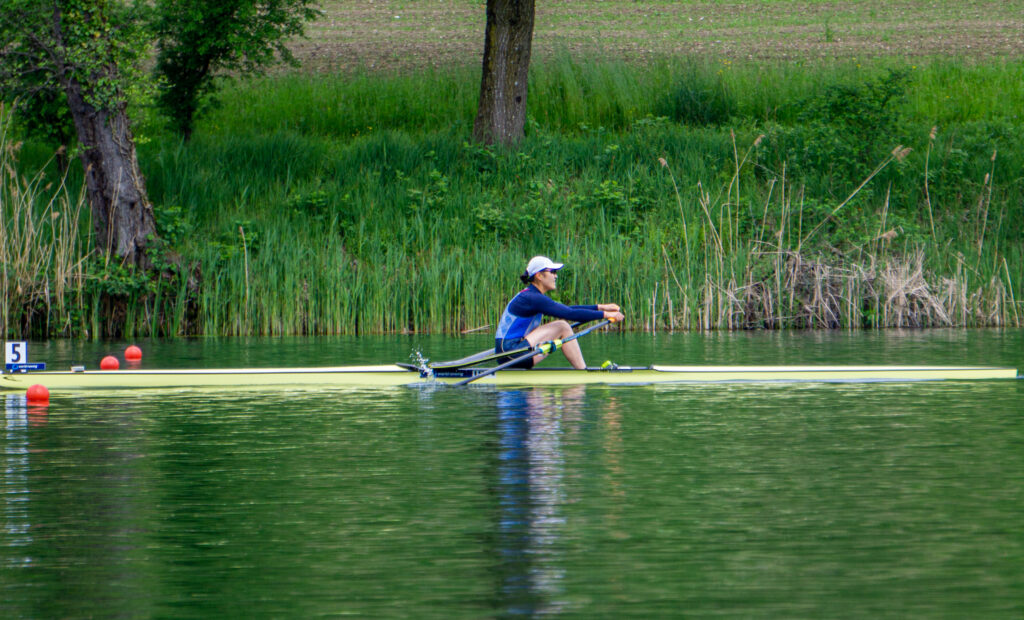
Men’s single sculls (M1x) – Heats
The men’s single sculls had the largest entry here Lucerne with 23 athletes contesting for just the two spots to the Tokyo Olympic Games. They will go through heats, repechages, semifinals and finals to try for the two spots.
Out to the early lead in Heat 1 was Russia’s Alexander Vyazovkin. Vyazovkin competed at the European Qualification Regatta, but due to the qualification system, he did not manage to claim a spot. But he’s looking on form here in Lucerne, leading the way down the course. In the early stages, Tunisia’s Mohamed Taieb was hot on his tails. But as the raced progressed, Romania’s Mihai Chiruta upped his rate and slid into second. Then Ward Lemmelijn made his move and Taieb fell back to fourth. Across the line, there was no stopping Vyazovkin who had clear water back to Chiruta and Lemmelijn.
Heat 2 saw a quick start from the Spanish sculler, Jordi Jofre Senciales, rating at over 40 strokes per minute. Jofre Senciales looked to have the race under control through the middle stages, but he might have underestimated Pilip Pavukou of Belarus. Pavukou put on the power in the third quarter of the race and motored past Jofre Senciales. Jofre Senciales seemed to lose his fight and took the rate down. Pavukou’s perfectly timed race meant he claimed the on spot directly into the Semifinal.
It is a mental game in the men’s single sculls and that was apparent in the third Heat. Bulgaria’s Kristian Vasilev was quick at the start, together with Trevor Jones of Canada. Vasilev found his rhythm a bit sooner to stride out to the lead as the athletes approached the 1000m mark. But Jones had the mental toughness to push back. He reclaimed the lead as they crossed into the final 500m. Vasilev did not have it in him to make another challenge and took his rate down. Jones had won the psychological battle.
There was no doubt about the front-runner coming into the fourth and final Heat in in the men’s single sculls. Natan Wegrzycki-Szymczyk of Poland has had a fantastic season this year and comes to the event with heaps of experience. The question was what shape John Graves of the United States would be in. But through the first 500m and Wegrzycki-Szymczyk had already claimed the lead. Graves tried to stay with him, but the tall and powerful Polish sculler had the best boat speed. Wegrzycki-Szymczyk looks on track to take one of the two spots to the Tokyo Olympic Games.
Semifinal qualifiers: Russia, Belarus, Canada, Poland
Lightweight women’s double sculls (LW2x) – Heats
Ireland has entered a young combination in the lightweight women’s double sculls, but they are a dominant duo. In the early stages of Heat 1, Ireland and Australia got off the line together, but it wasn’t long before the Irish made their move. They bumped up the power and stormed past Australia. Three crews would qualify directly for the Semifinal and the race for the third spot started to heat up. Brazil and Spain were tussling it out in the middle of the course. Into the final stages, Spain managed to hang on to their slight advantage over Brazil, while Ireland maintained open water ahead of Australia.
It was the first international race for the United States and China in Heat 2 and they were both looking to see how they shape up against the competition. Off the start it looked good for the Americans as they crossed the first timing mark in the lead. Poland was making the best of it behind them and China was not far off. Through the middle stages, Poland took a slight lead, but the United States pushed back. The tussle at the front moved them farther away from the third-placed China. But these threw crews were set to take the three spots into the Semifinal.
The only boatclass with three qualification spots available makes the lightweight women’s double sculls an interesting race to watch. In Heat 3 the Danish duo of Marie Morch-Pedersen and Mathilde Persson took the early lead and crossed the 500m mark out front. But it wasn’t long before the home favourites from Switzerland took over and by the halfway point the figurative cowbells were ringing. Switzerland managed to hold their lead ahead of Denmark, who in turn held off a charging South African crew. Greece was just off the pace and missed out on a direct spot to the Semifinal.
Semifinal qualifiers: Ireland, Australia, Spain, United States, Poland, China, Switzerland, Denmark, South Africa
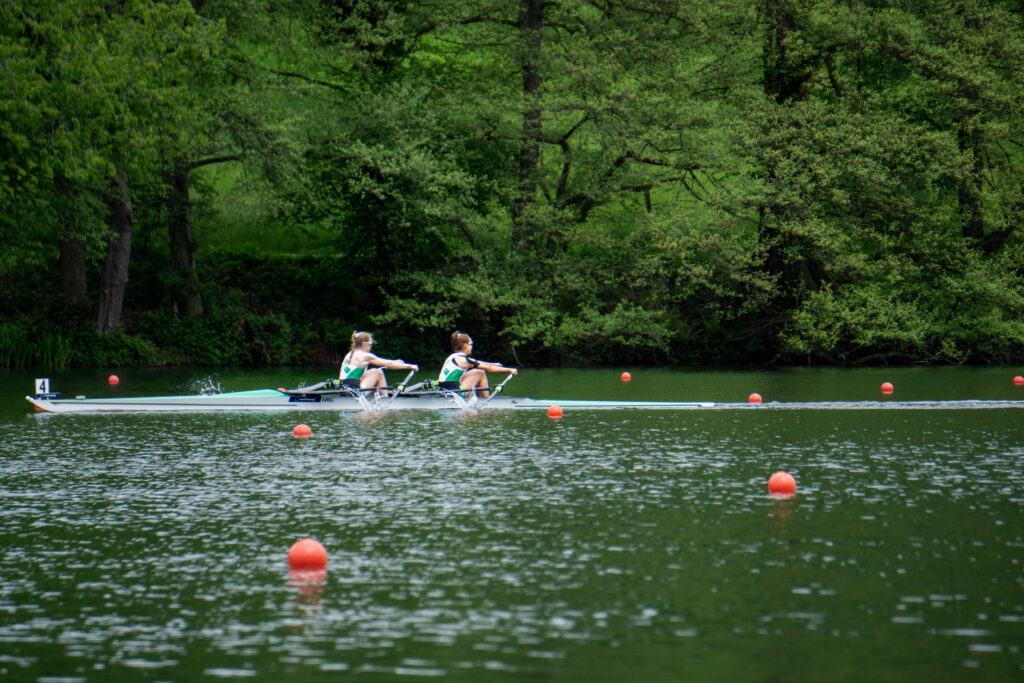
Lightweight men’s double sculls (LM2x) – Heats
With just two crews qualifying directly for the Semifinal out of this race, there was everything to play. In Heat 1, it was the Chinese who got off quickly. The new combination from the Czech Republic were flying with them and these two crews started to move away from the field. Through the middle of the race, they extended their lead with Japan and Austria charging hard. Japan wanted to show their sprint and they managed to overtake Austria in the last hundred meters, but it wasn’t enough to grab a spot directly to the Semifinal.
France decided yet again to switch up their line-up. They entered Victor Marcelot and Hugo Beurey in this race, leaving Olympic Champion Pierre Houin out of the boat. The choice rewarded them as the French were off to a good start in Heat 2. But they would also have to deal with the new line-up from Australia. Australia boated Sean Murphy, the world medallist in the lightweight men’s single sculls, together with Hamish Parry. France and Australia moved together down the course, with Denmark in third. Could the Danish make a move to get back into one of the two top spots? No, it was too little too late.
The third heat of the lightweight men’s double sculls saw a split race coming down the course. Canada and Switzerland were on opposite sides of the course, but had exactly the same speed. They would have to look far to see where they were in comparison to the other crew. But that’s what the Canadians and the Swiss did as they sprinted to the line. Luckily they were able to look back on the rest of the competition, knowing that they would have one of the two spots into the Semifinal. In the sprint, Canada took up the rate, while Switzerland powered down slightly to cross the line.
Semifinal qualifiers: Czech Republic, China, France, Australia, Canada, Switzerland
Men’s quadruple sculls (M4x) – Heats
The Russians showed their strength in the first heat of the men’s quadruple sculls. This boat finished eighth last year at the European Rowing Championships, but they were on form as they went to the start in Lucerne. Finding a solid rhythm Russia led the way ahead of France and Romania. In the final meters, Romania raised the rate to push ahead of the French. The only surprise was to see the skilled Lithuanian crew off the back of the pack. They must have been resigned to a repechage race.
Estonia is probably the favourite crew to win this event and they were trying to show that in Heat 2 of the men’s quad. They took such a lead in the first 500 meters that the rest of the field seemed to slip back with every stroke. Calm and collected, Estonia strode out in the final stages of the race to cross the line first.
Final qualifiers: Russia, Estonia
Women’s double sculls (W2x) – Race for Lanes
The women’s double sculls was the first preliminary race for lanes of the day, meaning all crews were already guaranteed a spot in the Final. But Russia wanted to show their strength and they took an early lead. Great Britain’s new duo of Saskia Budgett and Holly Nixon went with them. This young British crew recently took third at the European Rowing Championships and are here trying to qualify the boat to the Tokyo Olympic Games. Germany was closest to them, with the experienced Annekatrin Thiele in the bow seat. The order remained the same through the finish line, with Hungary and Nigeria coming through in fourth and fifth respectively.
Finishing places: Russia, Great Britain, Germany, Hungary, Nigeria
Women’s quadruple sculls (W4x) – Race for Lanes
Another Australian crew entered in the women’s quadruple sculls and the new combination from the Aussies was looking fantastic in the first half of the race. This preliminary race for lanes allowed crews to test their speed early in the weekend ahead of the final. France was making the best of it behind the Australians. France was second at the World Rowing Cup a few weeks ago and were looking strong again here in Lucerne. But coming into the final sprint, Norway surprised the field with their sprint. They overtook the French, with the Australians securely out in front.
Finishing places: Australia, Norway, France, Ukraine
Women’s eight (W8+) – Race for Lanes
China went storming out of the starting blocks to take a lead ahead of the European gold, silver and bronze medallists. Romania, the Netherlands, Germany and Russia were following. The question was, could China hold this blistering pace? Despite any challenges that Romania tried to put up, they could not rope back in the Chinese. China maintained a boat-length lead through the finish ahead of Romania. The Netherlands and Germany then had a slight advantage over Russia.
Finishing places: China, Romania, Netherlands, Germany, Russia
Men’s eight (M8+) – Race for Lanes
This was the first showing for the New Zealand men’s eight and everyone around the world was curious about their speed. They threw in the kitchen sink with their world medallist men’s pair and double Olympic Champion Hamish Bond in this line-up. Their gamble looked to have paid off as they got off to a fast start, followed by Romania. The Kiwis absolutely went for it as they strode down the course in fine fashion. Romania held their second spot ahead of China and Italy. These crews will all be back in the Final to try to collect tickets to Tokyo.
Finishing places: New Zealand, Romania, China, Italy
